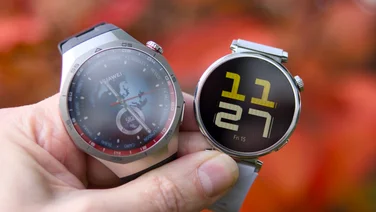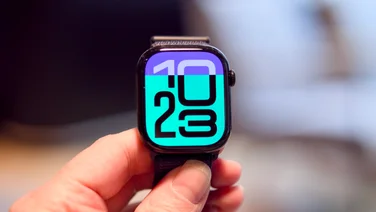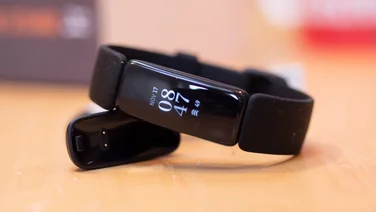To help us provide you with free impartial advice, we may earn a commission if you buy through links on our site. Learn more









- Rugged MIL-STD design
- Superb battery life
- Reasonable price
- No Garmin Connect IQ apps
- Breadcrumb navigation only
Garmin’s Fenix range of sports watches are peerless in terms of the features and performance they deliver, but they’re expensive. The superb Fenix 5 Plus, for instance, will set you back anywhere from £450 to £600, depending on how good a deal you can find.
Garmin’s new Instinct smartwatch is a little different. It has many of the features you’d normally associate with Garmin’s Fenix range such as GPS tracking, navigation tools and 14-day battery life. Crucially, though, at £270, you won’t need to remortgage your house to buy one.
READ NEXT: Garmin watch models explained
Garmin Instinct review: What you need to know
The Garmin Instinct is a smart sports-tracking watch aimed squarely at those keen on outdoor activities. This much is obvious from the outdoorsy design but also from the huge selection of outdoor activities it counts among its activity tracking modes – from mountain biking and open-water swimming to snowboarding and kayaking.
It has a crisp, black-and-white display and, thanks to its MIL-STD 810G credentials, it’s waterproof to 100m and super rugged. Plus, it includes a huge array of sensors and tracking tech, including a heart rate monitor, embedded GPS, a three-axis compass and altimeter. There’s also ANT+ and Bluetooth connectivity so you can connect it to your phone and a huge array of external sensors.
Although it can be used like more basic Garmin fitness trackers for simple step, sleep and activity tracking, this is a serious sports watch – a poor man’s Fenix 5 Plus, if you will – and it lacks only a few key features that its more expensive siblings include, such as full mapping, a colour screen and cycle power meter connectivity.
Garmin Instinct review: Price and competition
At £270, there’s nothing else that offers the same combination of features, performance and ruggedness you get with the Garmin Instinct. For a £100 saving, you can pick up the Ticwatch S2 – a Wear OS watch that’s MIL-STD tested – but it’s hampered by poor battery life.
Alternatively, £450 buys you Casio’s Pro Trek WSD-F30. This tough Wear OS watch has the upper hand over the Garmin device in that it offers full maps, but there’s no heart-rate monitor and no mobile app for reviewing data recorded during your adventures. And despite offering a variety of battery modes, you’ll be hard pushed to squeeze more than a day or so out of its battery whenusing the mapping app.
If you can forgo the tough credentials and navigation, though, Garmin’s Vivoactive 3 and Vivoactive 3 Music have very similar feature sets to the Instinct, along with NFC payments and, in the case of the latter, music playback. Both have batteries that last about a week between charges, too.
Garmin Instinct review: Design and display
Much like Casio’s WSD-F30, the Instinct’s look is reminiscent of a G-Shock watch. It’s a design that will likely split opinion but, to my eye, it’s more attractive than the Mobvio TicWatch S2. It appears robust and well-built, as you’d expect from a device that’s made to accompany you on all manner of outdoor expeditions. And you can get it in a large range of colours, including “graphite”, “tundra”, “flame red”, “sunburst”, “lakeside blue” and “sea foam” – there’s something for everyone, whether you’re after an eye-catching or a more understated look.
Despite its slightly brutish appearance, the Instinct is surprisingly comfortable. The optical heart rate sensor sits almost flush with the rear of the casing and the soft silicone strap never cut into my wrist as the Casio WSD-F30’s band did. And, although it’s almost as thick as the Fenix 5 Plus at 15.3mm, it’s a considerable 34g lighter (52g versus 86g). That’s still some way heavier than the Vivoactive 3 Music, but not so much as to make it an annoyance.
As it’s designed for use in all manner of environments, there’s no touchscreen. Garmin has instead opted for the classic five-button arrangement of its Fenix range. That’s a sensible decision because there’s nothing more frustrating than trying to use a touchscreen in the rain or cold or, indeed, when you have gloves on. The buttons’ functions take a bit of getting used to, but once you’re up to speed they make navigating the smartwatch simpler than swiping and tapping.









What’s slightly unusual about the Instinct’s screen is its two-part design. Depending on the screen you’re looking at, a small, circular complication in the top-right corner highlights a single piece of info. On the default watch face, it shows the date, while the current temperature is shown on the weather screen. It’s a nice design touch and certainly makes it easier to see key info, but I can’t help feeling that this unique layout is likely one of the main reasons Garmin hasn’t opened up the option to install Connect IQ apps.
The display is also a fairly low-resolution 128 x 128 pixels. That’s not as bad as it sounds when you consider it’s only 23 x 23mm in size and, importantly, the black and white MIP (memory-in-pixel) panel is easy to read in all light conditions, including bright sunlight. If you’re using the watch in the dark, it can be illuminated with a press of the top-left button.









Garmin Instinct review: Basic features and sports-tracking tools
As with most of Garmin’s sports watches, the Instinct’s interface primarily consists of a series of “widgets”, or data screens, which can be navigated using the bottom two buttons on the watch’s left side. Here, you can find heart rate, weather and calendar info, along with a summary of your activity levels of the day. By long-pressing the Menu button, you can also add widgets for sunrise and sunset, stress, music controls, temperature and moon phase, to name just a few.
Although it’s possible to add widgets for a compass, altimeter and barometer, these tools can also be quickly accessed by long-pressing the ABC (bottom-left) button. The latter two data fields are automatically calibrated when you use GPS but can also be set manually if you know your current altitude.









To use the watch’s alarm, timer or stopwatch, all you need to do is long-press the Set (bottom-right) button and select the appropriate option. From this menu, you can also set sunrise and sunset alerts, which is a handy feature if you want to make the most of the early daylight hours or avoid getting caught out when the sun comes down.
Logging an activity, on the other hand, is initiated by pressing the GPS (top-right) button and then selecting the appropriate sport. There’s a huge list to choose from that includes run, trail run, walk, treadmill, hike, climb, bike, ski, row, pool swim, strength, cardio and yoga. The standout mode as far as this extensive list is concerned is open water. With the exception of triathlon watches, not very many wearables record open-water swimming, so it’s great to see it offered on a device under £300.
Having said that, there’s also one notable omission in the form of a golf mode. That’s probably not a deal breaker for most people, but it’s a little strange that it’s been left out when it exists in all of Garmin’s Vivoactive range of devices.









Garmin Instinct review: Navigation and performance
In most of the watch’s outdoor activity modes, there’s a navigation screen that shows your location history via a breadcrumb trail. That in itself isn’t hugely valuable but the Instinct also has Garmin’s TracBack feature, which creates a route back to the start for you to follow based on the thirty most significant points on your outbound trip. Useful if you get lost out on the moors.
Alternatively, if you want to follow a predetermined route without having to retrace your steps, you can use the Garmin Connect app or the website to generate a course and export it the watch. Again, this only uses a breadcrumb trail and direction arrow to direct you but, if you’re mountain biking or trail running, that’s normally enough to be able to see at a glance if you’re on the right course or not.
What’s most frustrating about the watch’s navigation functions, however, is that there’s no way of making sense of your GPS coordinates in the context of OS grid references. On other Garmin devices, you can download a third-party app that shows you this information at a glance, but with no option to download any Connect IQ apps on the Instinct, there’s no way of doing this – or extending its capabilities in any other way, for that matter.









Despite that, there are still plenty of handy features for outdoor activities such as Auto Climb, which gives you handy insights into your recent elevation gain so you can adjust your efforts accordingly. In a similar vein, 3D Speed and 3D Distance factor in your elevation change when calculating your speed and distance during hilly activities.
Sadly, though the Instinct lets you follow planned workouts, it offers fewer insights after you’ve finished exercising. There’s basic info on how long you should recover for before your next workout, but the Instinct won’t show training load info or VO2 Max estimates as with many of Garmin’s other sports watches and fitness trackers.
As for battery life, the Instinct has an advertised battery life of 14 days in smartwatch mode. That’s largely in line with what I’ve experienced while using the watch, although, as with any sports watch, how long it lasts between charges will depend on how much you use GPS tracking. For normal GPS recording, Garmin claims the Instinct lasts up to 16 hours but you can extend this up to 40 hours in UltraTrac mode.
Garmin Instinct review: Verdict
Whether the Garmin Instinct is the watch for you primarily comes down to how much you value its tough credentials and navigational tools. If you can live without MIL-STD robustness, breadcrumb routing and compass, you might be just as happy with the Vivoactive 3, which costs around £170
On the other hand, if you’ve always liked the look of Garmin’s Fenix range of watches but have previously been put off by the price, the Instinct is a tempting proposition. The plasticky design won’t be to everyone’s taste, but the watch feels built to last and there’s nothing else at this price that offers quite the same combination of features.





